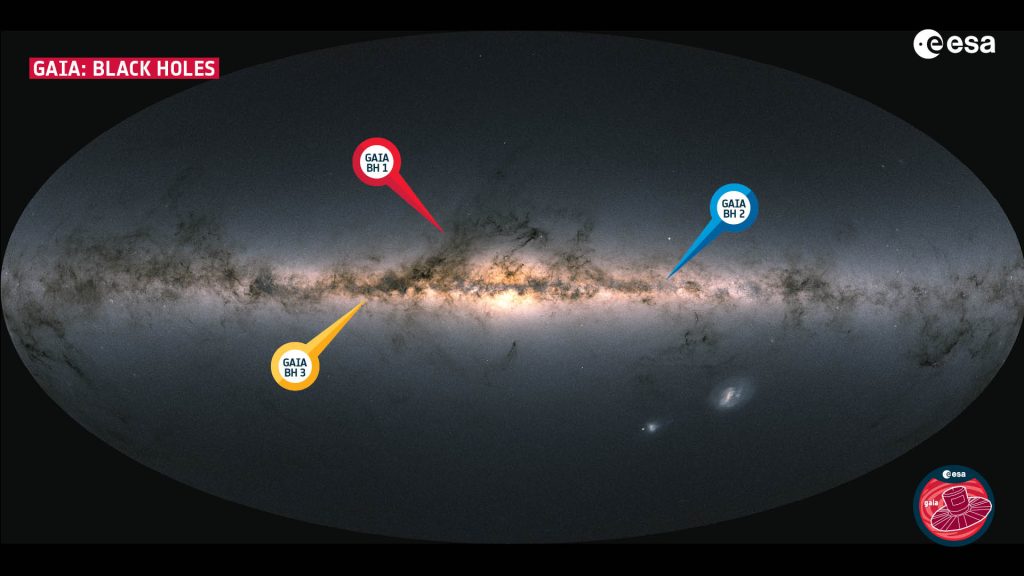Sleeping giant surprises Gaia scientists

Wading through the wealth of data from ESA’s Gaia mission, a team of scientists including astronomers from the University of Leicester have uncovered a ‘sleeping giant’: a large black hole, with a mass of nearly 33 times the mass of the Sun, hiding in the constellation Aquila, less than 2000 light-years from Earth.
This is the first time a black hole of stellar origin this big has been spotted within the Milky Way. So far, black holes of this type have only been observed in very distant galaxies. The discovery challenges our understanding of how massive stars develop and evolve.
Matter in a black hole is so densely packed that nothing can escape its immense gravitational pull, not even light. The great majority of stellar-mass black holes that we know of are gobbling up matter from a nearby star companion. The captured material falls onto the collapsed object at high speed, becoming extremely hot and releasing X-rays. These systems belong to a family of celestial objects named X-ray binaries.
When a black hole does not have a companion close enough to steal matter from, it does not generate any light and is extremely difficult to spot. These black holes are called ‘dormant’.
To prepare for the release of the next Gaia catalogue, Data Release 4 (DR4), scientists are checking the motions of billions of stars and carrying out complex tests to see if anything is out of the ordinary. The motions of stars can be affected by companions: light ones, like exoplanets; heavier ones, like stars; or very heavy ones, like black holes. Dedicated teams are in place in the Gaia Collaboration to investigate any ‘odd’ cases.
One such team was deeply engaged in this work, when their attention fell on an old giant star in the constellation Aquila, at a distance of 1,926 light-years from Earth. By analysing in detail the wobble in the star’s path, they found a big surprise. The star was locked in an orbital motion with a dormant black hole of exceptionally high mass, about 33 times that of the Sun.
This is the third dormant black hole found with Gaia and was aptly named ‘Gaia BH3’. Its discovery is very exciting because of the mass of the object.
Professor Martin Barstow from Space Park Leicester and the University of Leicester’s School of Physics and Astronomy is a member of the Gaia Collaboration and co-author of the study. Researchers from the University of Leicester have been at the forefront of the Gaia Collaboration since its very earliest days.
Professor Barstow said: “This result shows the incredible power and precision of Gaia in detecting the motion of astronomical objects like this. Stellar mass black holes are usually found from their extreme activity when they swallow material from their surroundings. This one is not active so can only be found by precision measurements of its motion in space. It is remarkable that it is so massive, testing our understanding of how black holes are formed and grow.”
“This is the kind of discovery you make once in your research life,” said Pasquale Panuzzo of CNRS, Observatoire de Paris, in France, who is the lead author of this finding. “So far, black holes this big have only ever been detected in distant galaxies by the LIGO–Virgo–KAGRA collaboration, thanks to observations of gravitational waves.”
The average mass of known black holes of stellar origin in our galaxy is around 10 times the mass of our Sun. Until now, the weight record was held by a black hole in an X-ray binary in the Cygnus constellation (Cyg X-1), whose mass is estimated to be around 20 times that of the Sun.
“It’s impressive to see the transformational impact Gaia is having on astronomy and astrophysics,” notes Prof. Carole Mundell, ESA Director of Science. “Its discoveries are reaching far beyond the original purpose of the mission, which is to create an extraordinarily precise multi-dimensional map of more than a billion stars throughout our Milky Way.”
The exquisite quality of the Gaia data enabled scientists to pin down the mass of the black hole with unparalleled accuracy and provide the most direct evidence that black holes in this mass range exist.
- More information on the discovery is available in ESA’s full press release: https://www.esa.int/Science_Exploration/Space_Science/Gaia/Sleeping_giant_surprises_Gaia_scientists
- The paper Discovery of a dormant 33 solar-mass black hole in pre-release Gaia astrometry by Gaia Collaboration, P. Panuzzo, et al. is published in the journal Astronomy & Astrophysics (A&A).
- Find out more about the University of Leicester


